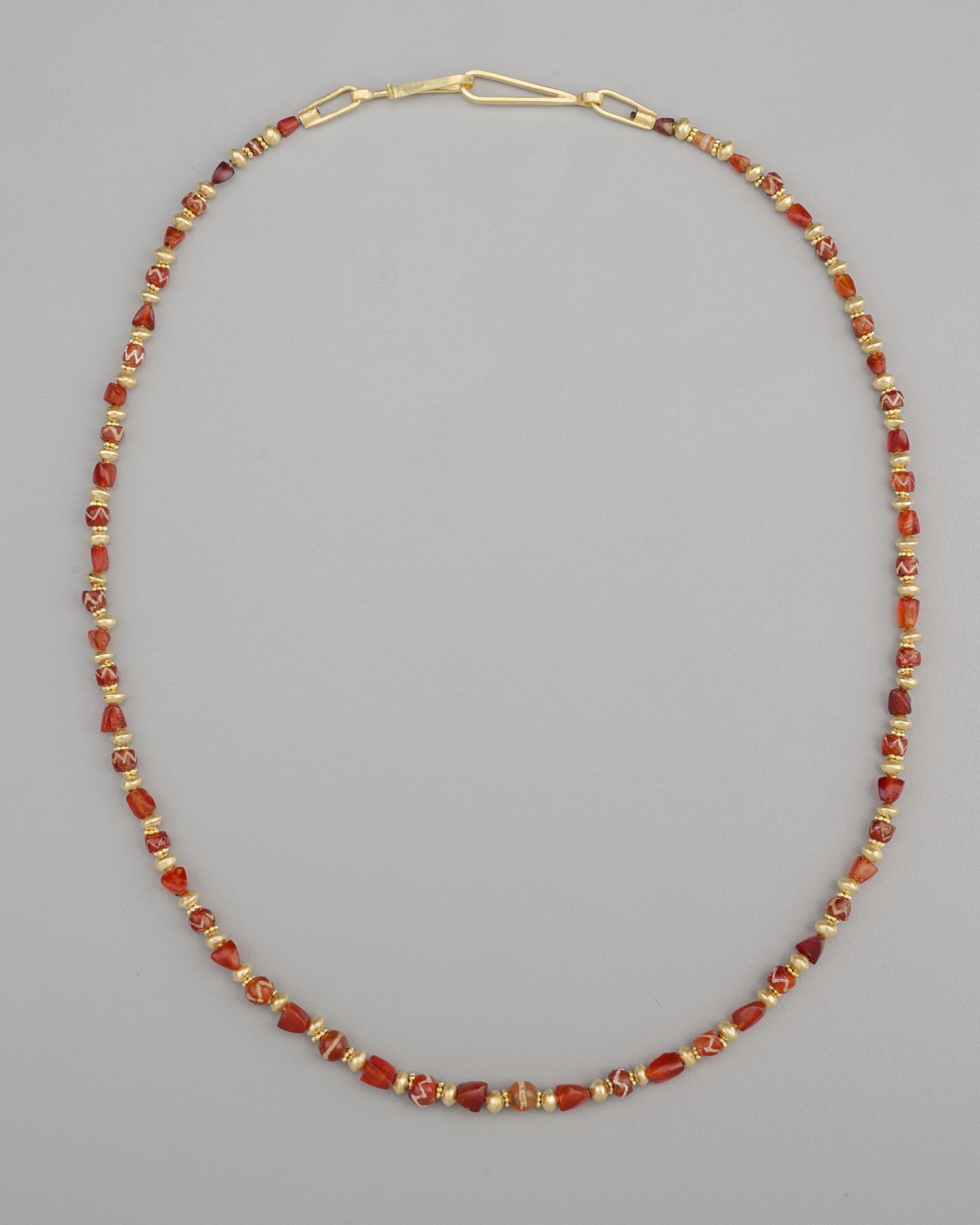Ancient Etched Carnelian and Round Gold Beads
Collection:
Carnelian
Material:
Carnelian, 20k gold
Size:
The necklace is 20 ½ inches (52 cm) in length. The necklace weighs 18.5 gm.
Price:
$6,975.00
A necklace of fifty-nine carnelian beads alternating with fifty-eight round 20k gold beads. Of the carnelian beads, twenty-nine are artificially patterned round beads, (called “etched”), and thirty are undecorated carnelian beads with alternating trapezoidal faces. Each of the etched carnelians are also faced with two 20k gold granulated ring beads. The beading tips and hook and eye clasp are 20k gold. The round etched carnelian beads are 5.5 mm in diameter with drill hole diameters of 1.5 mm. The short cylinder or drum shaped etched carnelian beads graduate in size towards the back of the necklace. They have a white zigzag line going around the bead. The largest is 4mm in length and 5 mm in width. The smallest is 3.1 mm in length and 3.5 mm in width. The drill hole diameters are 1.4 mm. The undecorated carnelian beads are basically rectangular solids with the opposing sides both ground down towards the ends of the beads to make triangular faces. If the bead is rotated ninety degrees along the axis of the drill hole, the next set of opposing faces make a triangle facing in the opposite direction. The sizes of these beads also graduate towards the back of the necklace. The largest of these is 5 mm in length and 4.8 mm at the widest point. The smallest is 3 mm in length and 3 mm in width. The drill hole diameters are 1.4 mm. The round gold beads are slightly flattened in form. They are 3.8 mm in length and 4.1 mm in width. The granulated ring beads are made up of six grains and they are 2.5 mm in diameter. The etching of agate and carnelian beads is accomplished by painting onto the surface of the bead as alkali (potash, white lead, and washing soda have all been reportedly used), and then subsequently firing the bead. This permanently whitens the area of the bead covered with the alkali. The whitening is not merely a glazing of the surface. The surface is often unaffected by this process; the whitening actually occurs beneath the surface and extends downward into the stone. The whitened areas may be raised on some specimen; in a few cases, the designs are sunken into the stone, the solution having acted like a flux as it was absorbed into the surface and melted the structure of the agate or carnelian. Etched beads have been manufactured since very early times. Beck attributed the specimens known to him to three main periods: Early (before 2000 BC), Middle (300 BC to 200 AD), and Late (600 to 1000 AD). Francis has expanded and revised this dating as follows: Early (2700 BC to 1800 BC), Middle (550 BC to 200 AD), and Late (224 to 642 AD). Etched beads from the earliest period have been found mainly at Mesopotamian and Indus civilization sites. The centers of their manufacture discovered so far are the Indus civilization sites of Lothal and Chanhu Daro. Middle period etched beads were found mainly at Indian subcontinent sites. Francis makes a strong case that the centers of manufacture of Late period etched beads was Iran and dates them to Sassanian times (224 to 642 AD). The etched carnelian beads in this necklace are likely from the Middle period, or about two thousand years old as are the undecorated carnelian beads.
